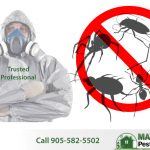
Where Do Termites Hide?
Contact Maximum For Pest Control Estimate. Home & Business Service. Experts Local Exterminators. Same Day Service Available With Maximum 4 Seasons Program www.maximumpestcontrol.ca (905) 582 -5502 or (905) 330-2102
Where do actually termites hide? And why is it that it is usually too late by the time you found them? Termites are active during spring time. It is the time of the year when they multiply and can do some serious damage to your house. During spring, you must exert extra effort to watch for termite infestation around the house, and do something about it quickly, once you find out that termites are present in your house.
Where are the termites?
Termites are what you would call subterranean creatures. The live under the ground so you do not see them. Digging is not going to help, as they live several feet underground. By spring, they are ready to take action and start eating wood in your house structure. What this also means is that they will start attacking your house from underground up.
- Crawl spaces – termites are found in spaces between the concrete posts. They will crawl in there and breed. The thing is, these crawl spaces must be properly sealed because if they are not sealed, they would serve as breeding tubes, especially if the post is made of wood.
- Sole-plate – this is the foundation of your house that has a slab of concrete. A sole-plate is a horizontal bar where the vertical posts are attached. If the sole-plate is close to the soil, then the termites can easily reach them. This usually happens if the sole plate is on the ground rather than inside it. Sometimes, a sole plate is made of wood, and this makes it all the more attractive to termites.
- Wooden Deck – if you have a deck, then there is a huge possibility that termites will use that as a breeding ground. Unpainted deck, or wood that is not cured, will attract termites. They love decaying wood because they can easily chew on it.
- Wooden Fence posts – termites are also found inside fence posts made of wood. They are easily accessible from the ground, and they are made of wood so it is easy for the termites to eat them and create shelter tubes inside them.
The Role of Moisture in Termite Infestation
When it rains, the water seeps through your house. And if there is moisture, termites will get attracted to it because they need water to live. If the wood is moist, it is also easier for them to build a nest tubes inside it. They will grow and multiply and before you know it, that wood is a goner.
To prevent this, you must always ensure that your gutter is not damaged. A damaged gutter allows water to seep through and damage the wood in the house that the gutter was supposed to protect. If the gutter is clogged, it also traps moisture, and this becomes a breeding ground for termites.
The plants around your house can also be a problem. Every time you water your trees, the wood becomes moist and soft, and it becomes a target for termites. Over time, termites can breed in the trees or the bark of small shrubs and bushes. In this case, you are better off calling a professional pest controllers service.
What Should You Do?
Termites require a special kind of treatment. You have to look for experts who know what chemicals to use to treat your wood. Even ants control service technician can help do this, if they are termite certified exterminators, as they often belong to the same group of exterminators. The experts also know what kind of insecticide to use to prevent termites from attacking your plants and trees.
If you cannot find a pest controllers company near you, just launch a search engine and type “pest control near me”. The search results will use your location and show companies that are near your home. Make sure you read their online reviews before you hire the experienced pest control and treatment company. Or you can simply get in touch with trusted pest control experts 905-582-5502



